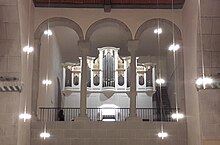Wilhelm (organ builder)
The Wilhelm family of organ builders was a family of organ builders from Weißenbach in the Werra-Meißner district in northern Hesse . It was active in the 18th and 19th centuries with one branch and four generations in northern Hesse and the other branch with two generations in northern Lower Saxony .
Georg Peter Wilhelm

Georg Peter Wilhelm ( 1733 in Weißenbach, † July 14, 1806 in Kassel ) was the family's first organ builder. He was a son of the miller Georg Wilhelm and his first wife, Martha Elisabeth b. Heinemann. He probably learned the craft from the court and city organ and instrument maker Hermann Peter Dibelius (1700–1774) in Kassel. He then went into business for himself in his birthplace and went back to Kassel in 1766 to repair the organ in the Brothers Church. There he became Dibelius' successor as court organ builder and city organist. He received his first commission from the court in 1771 when he was supposed to replace the bellows of the castle church organ. A total of 28 large new buildings, repairs and conversions by Georg Peter Wilhelm are known from the years 1766 to 1807, including the large organ on the imperial loft in the Kaufungen collegiate church , the practically completely preserved organ of the chapel in Escheberg Castle and the water-powered barrel organ in the Wilhelmshöhe mountain park by 1778.
His first marriage to Philippe Henriette geb. Deinet, daughter of the court beer brewer, ended with her early death; the two children from this marriage also died early. The second marriage with Johanna Elisabeth geb. Engelhardt had at least seven children, and three of the sons were also organ builders.
Georg Wilhelm Wilhelmy and Johann Georg Wilhelm Wilhelmy
Georg Peter Wilhelm's half-brother Georg Wilhelm Wilhelmy (1748–1806), who was 15 years his junior , learned the trade of organ building from him. In 1766 he took over the workshop of his half-brother who had migrated to Kassel. Since the equality of his second name and family name bothered him, he added an "i", later a "y" to his last name. Among other things, he repaired several organs in the Altes Land and, in 1781, relocated there with his family on the occasion of a thorough organ repair at St. Cosmae Church in Stade . He became an admirer of the baroque organ builder Arp Schnitger and devoted himself mainly to the care and maintenance of the instruments of his great role model. He also built his new buildings exclusively in Schnitger's style. He built the organs in St. John's Church in Visselhövede (1779/80), St. Vitus Church in Belum (1783–86), and St. Mary's Church in Balje (1783–86) and in the St. Fabian Church in Ringstedt (1788) and soon became one of the most sought-after organ builders in the duchies of Bremen and Oldenburg . After his death, his son Johann Georg Wilhelm Wilhelmy (1781–1858) took over the workshop.
Adam, Heinrich Andreas and Georg Wilhelm
Georg Peter Wilhelm's sons, Adam, Heinrich Andreas and Georg, worked partly together, partly independently, and manufactured pianos as well as organs . Adam Wilhelm (1774–1808) died at the age of 34. Heinrich Andreas Wilhelm lived temporarily in Marburg "without a regular income". Georg Wilhelm (1781–1838), as Adam's successor, often complained about the lack of orders and moved from Kassel back to the countryside in order to be able to support his large family with a little agriculture. Small craft businesses like his increasingly suffered from competition from larger workshops, some of which were manufactured using steam-powered machines. From the hands of the three, about 30 larger works from the period from 1811 to 1836 are known, including the organ built by Georg Wilhelm in 1816 in the Protestant church of Frielendorf - Verna in the Schwalm-Eder district in North Hesse .
Carl and Gustav Wilhelm
With Georg Wilhelm's sons Carl, “court organ builder without salary”, and Gustav, the family's organ building tradition continued, as did the tight economic situation. Gustav Wilhelm initially worked in his brother's workshop, later became self-employed and finally succeeded his brother as the last court organ builder in Kassel. A total of about 50 works are documented for the two in the years 1838 to 1870. The organ in Abterode , built in 1869 by Gustav Wilhelm, has 23 registers and around 1300 pipes; by Carl Wilhelm, among others, the organ built in 1844 in the church of Niedenstein with its two manuals and 18 stops , which has been extensively restored since autumn 2019.
Carl Conrad Wilhelm
The only representative of the fourth generation was Gustav Wilhelm's son Carl Conrad. He got into such serious financial difficulties that he was temporarily imprisoned and had to have his commissioned work carried out by representations. His wife emigrated to the USA with the children , and he himself eventually went this way too. From the years 1880 to 1886 around 20 of his works are known in Germany.
Footnotes
- ↑ Christian Hilmes: Pastor history of Niederzwehren: Elaborated from sources . BoD, Norderstedt 2019, ISBN 978-3-7504-2656-6 ( excerpt from GoogleBooks [accessed on February 10, 2020]).
- ^ The organ portrait (265): The Wilhelm organ in the Ev. Gutskapelle, Escheberg
- ↑ http://www.nomine.net/belum-st-vitus
- ↑ https://kirchengemeindelexikon.de/einzelgemeinde/balje/
- ↑ Little Ringsteder Organ History
- ↑ Back to the original sound: The Niedenstein organ renovation begins in September. At Lokalo24.de, May 31, 2019
Web links
literature
- Erwin Althaus, Peter Brusius: The organ builder family Wilhelm . Self-published, Marburg 2013.
- Ferdinand Carspecken: Five Hundred Years of Kassel Organs; A contribution to the culture and art history of the city of Kassel. Bärenreiter Verlag, Kassel 1968.
- Eckhard Trinkaus: organs and organ builder in the former district of Ziegenhain (Hesse). Elwert, Marburg 1981, ISBN 3-7708-0713-8 .